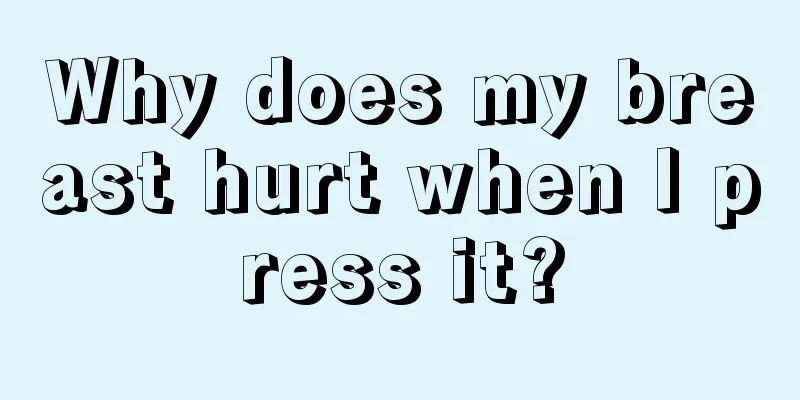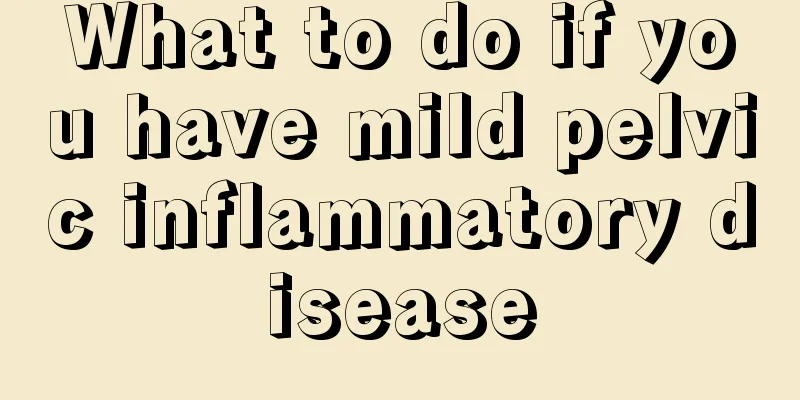Why does my breast hurt when I press it?

|
Many people feel pain when their breasts are gently pressed. This cannot be ruled out as being related to physiological factors, such as before and after menstruation, during puberty, during pregnancy, and right after giving birth. During these periods, the breasts are very sensitive, so it is normal to experience pain. If there is abnormal pain, you must seek examination and treatment in a timely manner. Breast pain types Breast disease = breast cancer? Female compatriots seem to be very sensitive to these words, especially those who suffer from breast pain from time to time. Experts point out that pain can be divided into several types. Some are physiological pains and there is no need to be too nervous, while some pathological pains should be taken seriously and medical treatment should be sought in time. Don't worry too much about physical pain Physiological breast pain is often related to menstruation, and breast tenderness about a week before menstruation is considered normal. Breast pain during adolescence: The breasts of girls aged 9 to 13 begin to develop, and dome-shaped nodules the size of peas or beans appear in the breast tissue under the nipples, which cause slight pain. After menarche, it will disappear on its own as the breasts mature during puberty. Menstrual breast tenderness: It is the most common type of breast pain, accounting for about 65% of all breast pain, with an average age of occurrence of 35 years. The pain usually occurs or worsens 3 to 7 days before menstruation and gradually disappears or eases after menstruation. The severity of the pain varies from month to month, and is often felt as a heaviness, distension, dull pain, or occasional brief tingling sensation. There are also tender breast nodules, which are aggravated by pressure, movement or lifting objects. Breast tenderness during pregnancy: Some expectant mothers experience breast tenderness around 40 days after pregnancy because the placenta and villi secrete large amounts of estrogen and progesterone, which enlarge their breasts. In severe cases, the pain may last throughout the pregnancy and usually does not require treatment. Postpartum breast tenderness: Breast fullness, hardness and pain often occur 3 to 7 days after delivery. This is mainly due to the effects of prolactin, venous filling, interstitial edema and milk filling. Therefore, mothers should breastfeed as early as possible. If there is a lump, you can apply hot compress and massage the lump before breastfeeding, or you can use a breast pump to extract milk to promote the patency of the mammary ducts. Breast tenderness after abortion: Some women feel breast tenderness and can feel a lump after abortion. This is because the pregnancy is suddenly interrupted, which causes the hormone levels in the body to drop sharply, causing the newly developed mammary glands to suddenly stop growing, resulting in breast lumps and breast pain. Breast pain after sexual intercourse: People with low libido or disharmonious sex life cannot achieve sexual satisfaction, so breast congestion and swelling are not easy to subside. Continuous congestion will cause breast pain. |
<<: Why do I have a headache during my period?
>>: How to relieve back pain during menstruation?
Recommend
Why do I feel itchy all over my body when I am eight months pregnant?
After pregnancy, due to the influence of hormones...
Will I be irritable in the early stage of implantation?
After a woman's sperm and egg combine and the...
What are the benefits of taking vitamin E for women?
Our human body needs a variety of vitamins, and t...
What causes women to be loose below?
Looseness in women's private parts may lead t...
What causes poor uterine contraction?
Under normal circumstances, a woman's uterus ...
Can rodenticide poisoning lead to death? Is there any specific drug treatment?
Author: Qiu Zewu, Chief Physician of the Fifth Me...
Can I eat udon noodles during menstruation?
Udon noodles are a Japanese specialty noodle dish...
Is it better to have oil in breast milk or not?
Breast milk is the safest food for babies. It con...
Why do women have spots on their cheeks?
The emergence of the spot problem is related to m...
A woman dreamed that she had lost 4 teeth.
It is ridiculous that a woman will die if she dre...
Reveal what you want to know: How long is the vagina?
Many people are curious about how long a woman’s ...
What is the cause of hard lumps in the armpits?
There is a phenomenon that will appear after a wo...
What foods can women eat to reduce internal heat?
Many women have the problem of getting internal h...
[Healthy Life] Teach you how to easily get through menopause, please check out these expert suggestions!
Many diseases increase significantly during menop...
What to do if there are lumps in the milk
After giving birth, women still need to breastfee...









